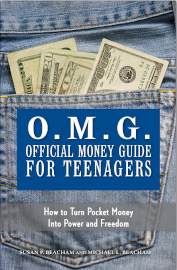The Official Money Guide for Teenagers packs a ton of information into its 48 pages. Although the book is ideal for teens, pre-teens can and should jump into the first sections on budgeting and saving.
The authors present basic consumer economics from a practical perspective. Using illustrations, charts, and graphs, they both “tell” and “show” the economic concepts. They often use practical life situations to explain a point. “Awkward Money Moment” sidebars present scenarios that might occur in real life that require some economic savvy, scenarios such as the teen who has been saving up for a new soccer uniform, but is confronted with a dilemma when a friend invites her along to an amusement park. That teen has to sort out which use of her savings is more important to her.
The book has seven sections: Budgeting and Choices, Saving and Investing, Ways to Pay, Credit and Credit Cards, Identity Protection, Philanthropy, and Insurance. While pre-teens and some teens might not yet need to be concerned about all of these areas, they soon will.
The Official Money Guide for Teenagers is up to date with its coverage of credit cards, debit cards, prepaid debit cards, ATM cards, direct debits, PayPal (and other online payment services), FICO scores, and identity theft. I like the way they talk about the snowball effect of unpaid credit card debt using both a visual illustration with snowballs as well as a chart showing the math. Their coverage of ways that identify theft might take place is excellent.
My only quibble has to do with their treatment of savings and interest. We are in what should be a temporary era of extremely low interest rates. Interest rates are low to non-existent on savings accounts causing money saved in bank accounts to lose value as inflation eats away at its value faster than interest can compensate. Whether or not this situation continues, it seems an important factor to point out. While saving is absolutely critical, promoting savings because of the value of compound interest is misleading in our present economy. But perhaps that’s a topic best reserved for a more thorough economics course.
In the Official Money Guide for Teenagers, the authors have squeezed a lot of valuable information into relatively few pages. They’ve made it attractive and easy enough to read that teenagers might even read it without your prodding.












